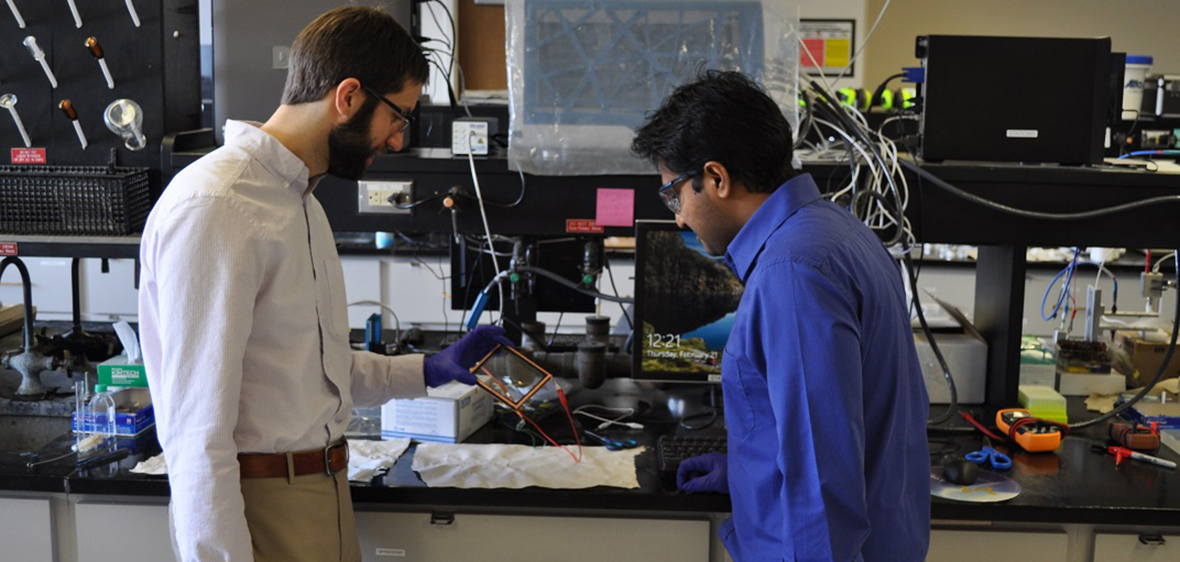Picking the darkness for tinted windows, from light to dark, with the twist of a dial is now possible with a new process developed by Chris Barile's lab in the College of Science using nickel oxide, lithium ions and a gel electrolyte.
The dynamic windows, sometimes called "smart windows" reduce glare without obstructing views while increasing the energy efficiency of buildings and automobiles - with lighting, heating and cooling cost savings.
"Right now, in one minute we can switch uniformly between a clear state and a state blocking 94 percent of light," Barile, a professor in the University's Chemistry Department in the College of Science, said. "In lab tests we cycled the glass between opaque and transparent at least 4,000 times without significant degradation, and they are compatible with flexible layers."
When voltage is applied to the glass, the electrochromic materials change color, so when the electrical charge is applied the nickel oxide turns dark, and the lithium ion layer further darkens the glass - and the darkness is variable depending on the amount of electrical charge applied.
This new class of dynamic windows Barile and his team have developed, which combines reversible metal electrodeposition with ion insertion chemistry, includes layers of nickel oxide, lithium ions, and a gel electrolyte coating the inside of a double pane window. When a current is applied to these layers, the nickel oxide soaks up the lithium ions and turns opaque. The current also causes the electrolyte ions to form metal deposits on the other pane, which blocks even more light. Neither of these two effects have a strong color bias, eliminating the color cast that is seen in existing versions of dynamic windows.
The uniform nature of device switching enables these windows to access any intermediate state of grey while maintaining an aesthetically pleasing view through the window.
Dynamic windows are widely explored, but they have not been extensively commercialized due to problems associated with color, cost, switching speed and durability.
"There are a lot of possibilities for commercialization ranging from residential windows to car sunroofs to sunglasses," Barile said. "We've spoken to dozens of companies who are interested in the technology, and we could also launch our own start-up company. Right now, we are trying to de-risk the technology as much as possible and evaluate what options make the most sense."
Barile's technique harnesses the optical properties of metals while facilitating movement of the ions across the pane of glass, which enables devices to be constructed on a large scale. In short, this architecture enables windows to switch rapidly and uniformly.
The lab has, so far, scaled the technology to a 4-inch by 4-inch piece of glass.
"Scale-up is a grand challenge," Barile said. "We would love to build multi-square-foot windows, but we will need our small laboratory prototypes to switch more rapidly before we get to that point. If we can design windows in the lab that switch in a few seconds, we will be able to design real windows in an industrial setting that switch in a few minutes."
The results of the research indicate that hybrid metal-based dynamic windows are a promising alternative to those based on traditional electrochromic materials.
"I think we've really exceeded our own expectations for how fast the research has progressed," Barile said. "Applying reversible metal electrodeposition to smart windows is an almost completely untapped avenue of research, and we currently have more good ideas than we have time to explore. The novelty of the approach has allowed us to focus on a few very good ideas and make the most out of those."
Barile has three graduate students working with him on the project, including Shakirul Islam who worked on a recently published scientific paper. Three undergraduates work on other aspects of the window work.
"It's incredibly exciting going into the laboratory every day knowing that at any given moment, we have an opportunity to build a record-setting device," Barile said.
The scientific paper on their project was published Feb. 25 in the journal Nature Energy. The paper's authors are Barile, Shakirul Islam from the University of Nevada, Reno College of Science, Tyler Hernandez from the Department of Chemistry at Stanford University and Michael McGehee the Department of Chemical and Biological Engineering and the University of Colorado.












